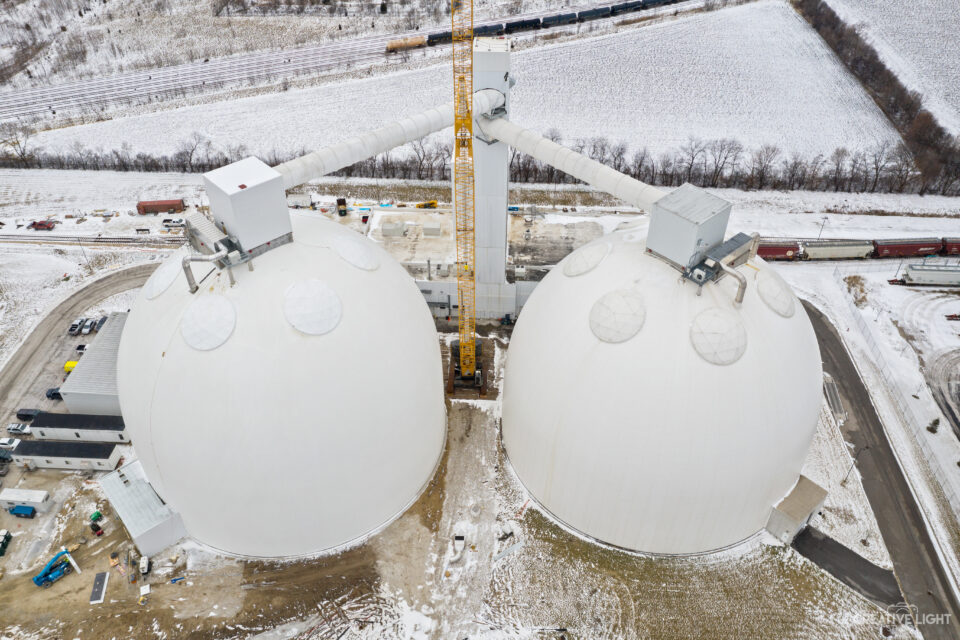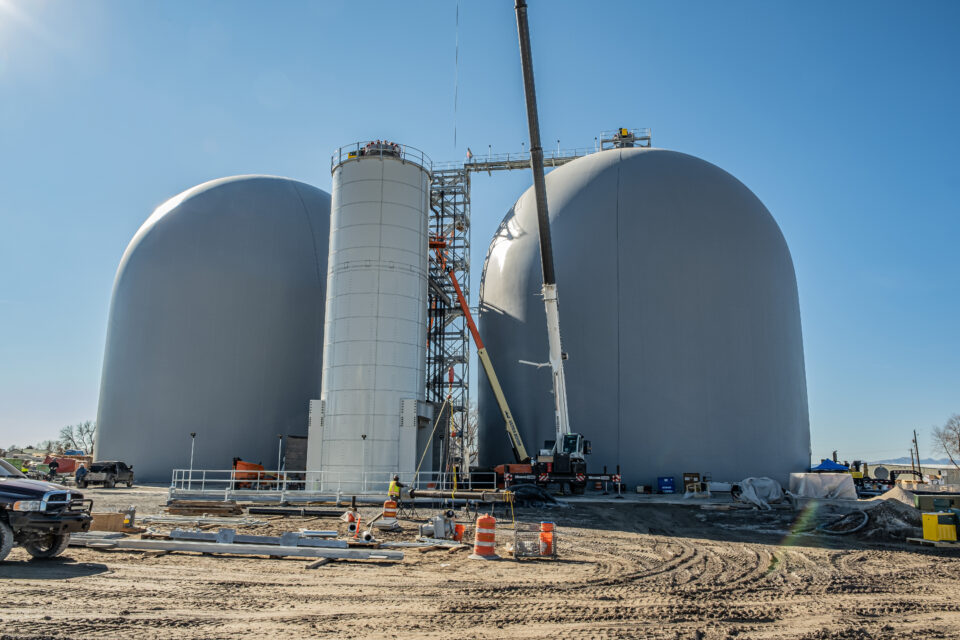If the ever-growing Dome Technology portfolio is any indication, domes are becoming a go-to solution for companies storing a wide variety of dry-bulk products.
In 2022 Dome Technology’s team tackled 17 construction projects for products ranging from salt to sugar with wood pellets topping the list in frequency. In 2021 the number of construction projects was similar—cement powder was the star that year—but Dome Technology also tacked on 20 engineering projects.
A dome’s appeal is amplified when customers discover Dome Technology not only builds the storage structure but also designs customized reclaim systems to match. Here is an overview of some of the recent projects:

American Crystal Sugar — Illinois, USA
Dome Technology recently constructed a DomeSilo for repeat customer American Crystal Sugar in Montgomery, Illinois. This 60,000-metric-ton refined-sugar dome was built adjacent to the distribution hub’s existing dome from a 2017 collaboration between the companies. The new dome is 184 feet in diameter and 146 feet tall, similar to the first DomeSilo.
Dome construction was just one part of this project puzzle. The team also adapted existing infrastructure to provide rail loadout. Before this project, sugar was delivered to the site by rail, stored in the dome, then distributed by truck. To expand services, ACS asked Dome Technology to modify the rail system to not only accept rail cars but also load them. “Some of their clients didn’t have truck receiving; they had rail receiving. So moving to rail distribution would diversify who they could sell to,” Dome Technology sales manager Daren Wheeler said.
On the fabrication side, Dome Technology built and installed a large tube gallery that connects an existing bucket elevator to the new DomeSilo, allowing the company to optimize conveyance and protect product integrity. Built in Dome Technology’s shop, the tube gallery is 13.5 feet in diameter for ease of maintenance access and extends 160 feet to connect the bucket elevator to the new DomeSilo.
The tube gallery is essential to the project because it helps keep the temperature and moisture levels consistent during conveyance. “As it’s being transported, it protects the sugar. That’s the benefit—(the sugar) is 100 percent protected from the elements,” Wheeler said.
Fabrication of a round tube gallery requires precision, and bids from outside manufacturers were cost prohibitive. The project was moved to the Dome Technology shop at company headquarters as a cost-saving measure and allowed for greater quality control. “It was pretty technical, and it speaks a lot for where we are going with fabrication,” Wheeler said.
The tubes’ exteriors were finished with insulated paint. Loaded with tiny ceramic discs, this paint boosts insulation values and was a customer request. The gallery was installed in 18 hours.

Bridgesource — Utah, USA
Two DomeSilos with specialized systems have been built for cement-product provider Bridgesource in Ogden, Utah, USA.
Fly ash or cement is pneumatically conveyed to one of two domes, the centerpiece of the storage facility. Each dome is 108 feet in diameter and 120 feet tall with a capacity of 32,000 short tons cement (25,000 short tons fly ash) each. Reclaim is achieved using an aerated floor system and side discharge. The DomeSilos will also be capable of transitioning to cement storage if necessary.
Trains deliver and discharge product into the pneumatic transport equipment; Dome Technology also constructed a steel building over the pit. From the domes, the product is conveyed to one of two 300-short-ton day bins for truck loading or a batch plant. A 700-foot pipe transports fly ash and cement from the pit to the batch plant.

Drax — Alabama, USA
Renewable-energy giant and repeat customer Drax completed another dome-centered wood-pellet facility, this time in the southern United States.
Located in Demopolis, Alabama, this new site features two storage domes 90 feet in diameter and 135 feet tall. Both can store 10,000 metric tons apiece and are designed with a 100 percent live-reclaim floor system.
Product is reclaimed using a sloped hopper floor system, and the domes are fitted with state-of-the-art safety systems, including aeration, heat sensors and gas-monitoring sensors.
The site is the epitome of efficiency. Pellets are produced at an on-site plant, then belt-conveyed to a bucket elevator, where they climb the first dome. At the top, the pellets enter a diverter, where they are directed to the desired dome.
Inside both domes, an innovative live-reclaim floor system imagined by Drax and built by Dome Technology is built around a V-shaped floor so product slides easily across the steel-plated floor. According to Dome Technology sales manager Lane Roberts, the domes’ tall and narrow shape fit the available footprint while still maximizing capacity and live-reclaim capabilities.
“It really does cut down operational costs because you don’t have a lot of equipment to maintain, and you don’t have to have operators in there,” he said.
Pellets leaving the dome are conveyed about 1,000 feet to the river port, where they are loaded onto barges.
General appeal
Versatility just might be the greatest of all dome virtues. Whether at a portside location with a high water table or a landlocked grain facility, domes boast benefits for all stored products in any environment.
Looking just a bit into the future, Dome Technology team will complete several large-scale projects in the United States and abroad. A DomeSilo is under construction for a Middle Eastern sugar refinery, and Titan Cement is building a dome in Florida and another in Virginia. An international cement company has hired Dome Technology to build a 50,000-metric-ton dome in the southern U.S. and a 25,000-metric-ton dome in South America. As more companies learn about dome benefits, Dome Technology’s executive team expects the dome will continue to grow in popularity.
Editor’s note: This is an excerpt from the Summer 2023 edition of Dry Bulk magazine.